The Ultimate Guide to Facebook Ads (Demographics & Ages Ranges)

Brace yourselves!
You are about to find out powerful information on Facebook demographics, especially different age groups, age categories, and ranges – to overturn the way you reach the right Facebook target audience.
But, why do demographic age ranges and targeting the right audience age groups matter when you market your business?
The long answer: This entire blog post.
The short answer: Marketing to the Right Age Demographic groups through Facebook Ad targeting increases your revenue.
With that said, here is the list of topics you need to be familiar with to outperform your competition when running FB Ads:
- Core Considerations For A Business
- The Problem
- The Solution
- The Key Part Of The Solution – Knowing Your Customers Well
- So Who Is My Target Audience?
- What Are The 4 Types Of Audiences?
- 4 Types Of Market Segments
- Facebook Marketing And Some Demographic Factors
- How To Target The Right Demographics Age Ranges – Example!
- Using Age Demographics For Advertising On Facebook
- Final Word!
-
People Also Ask
- What age group or demographic do most advertisers target?
- What is a demographic targeting or a targeted demographic?
- What are the advantages of demography?
- What are the demographics examples?
- How do you target an older demographic?
- How do you identify your target audience?
- Why is the target audience important?
- What does it mean by understanding your customers?
- What age groups does Facebook Target
- What is an example of a Target audience?
- What age demographic uses Facebook the most?
- Why is generational marketing important?
Let’s start here.
Core Considerations For A Business
Let’s begin with a simple question.
WHAT DOES YOUR BUSINESS REVOLVE AROUND?
Your products?
We thought that would be your best bet.
But the thing is, that’s not the wrong answer, TRUE!
However, what’s important to know is, that’s not the ONLY right answer.
The Problem
Here’s the thing:
WHAT IS A PRODUCT WITHOUT PEOPLE FOR WHOM YOU MADE IT?
What good is your product if it doesn’t reach the right demographic age ranges?
Marketing your products to the right age demographics is as important as creating the right product that eases the right target audience and age groups’ pain points.
What if you learn one day that you could have used the wrong age ranges for the survey?
What if you learn that you could have been targeting incorrect ages or inappropriate age brackets to market your business?
For a fact, most business owners do not understand the right age categories or other demographic factors their right audience could actually be falling in.
There are many more marketing mistakes too you could be making but after having made them, WHAT TO DO?
The Solution
In a nutshell, the success of your business comes down to these 3 key elements:
- Creating the right product that has a demand
- Targeting the right audience that demands the product
- Using the right marketing strategy to reach and convert the right audience.
Now that you have done it all wrong all along, what next?
Should you just cry over spilled milk and move over if that has happened to you?
There’s an alternative solution to this situation as well:
You could find your business another focus to earn revenue from and make up for the lost bucks, if at all possible!
The first option is easy as heck.
But the second is the best practical approach, especially if you love your ad dollars and want to see them coming back to you.
So, keep reading to learn how to get back your market share if you lost it to targeting the wrong marketing demographics (different age brackets, relationship status, and education level or job titles, etc.).
Let’s zero-in on how to focus on the crucial aspects of your business’s success, your CUSTOMERS using Demographics (especially the age demographics).
The Key Part Of The Solution – Knowing Your Customers Well
It is crucial to determine HOW WELL YOU KNOW YOUR CUSTOMERS!
What’s more important?
Making efforts to improve your knowledge of your targeted audiences and customers.
As it is a broad subject, your current read would only cover the demographic aspect related to your clients on Facebook. You will find a special emphasis placed on the different age ranges for the survey you conduct for audience analysis covering various age groups.
But WHY FACEBOOK only?
Here’s why:
Using Facebook To Learn About And Target The Right Demographics And Age Groups Increase Your Success Rates MANIFOLDS
Let’s only touch the tip of the iceberg to see what lies underneath. Shall we?
a. Age and Gender Demographics
We are social states that Facebook’s use has increased over time, and more than 34% of the audience is under 25 years of age (as of July 2018).
Pew Research Centre shares interesting demographic and other stats about Facebook, especially among the American population. It states that the percentage of women using Facebook is higher than that of men, as is college degree owners’ rate compared to those of high school diploma owners.
SproutSocial quotes that more than 50% of teens are Facebook users.
Can you not see the potential of the platform you can utilize to target the people your business is most interested in?
And guess what, the info on demographics Facebook has, is not the only good news for business owners and marketers.
There’s more for you, all of you businesses out there!
b. Other Valuable Facebook Stats For Marketers And Business Owners
We are social declares Facebook messenger app to be the most-downloaded mobile app (as of 2018).
Following in an optimists’ footsteps, you could think of many of them as your potential clients.
Facebook Newsroom announces shutting down 583 million fake accounts only in the first quarter of 2018, most of those within minutes of the account registrations too. Imagine the massive amount of genuine-ness the platform offers (and the efficacy of the platform).
“We are social” claims that each user is likely to spend 10-12 minutes on Facebook each time they log in. This gives you an estimate of time as well as the potential to find and target the right clients for yourself.
Hootsuite says that more than 88% of Facebook users access the platform via mobile..
A Facebook Inc. conference in July 2018 said Facebook had 80 million Facebook pages. Hootsuite’s Social Media Barometer report, 2018 claims that Facebook happens to be the top marketing platform choice for both B2B and B2C businesses.
This suggests that even your competitors are on Facebook.
And last but not least!
Hootsuite goes on quoting that the Ad revenue for mobile Ads increased more than 50% last year.
What does that suggest?
In a nutshell, Marketers are rationally using Facebook’s data to market to the people their business matters to. And this is getting them some well-deserved results too.
c. What should you make of it then?
This calls for you to explore the nitty-gritty of Facebook customer research, and we’d be discussing the demographics part for now.
But before going into the details, let us take an overview of “Demographics” as per Facebook for Business.
In an attempt to explain audience insight, Facebook states *Know your audience like never before… See age and gender breakdowns, education levels, job titles, relationship status, and more*.
So these are some of the demographic factors Facebook takes into account. We have also touched every important aspect that makes Facebook Advertising the most valuable part of your advertising strategy.
Let’s now head to the next section to learn practically everything about the Target Audience.
So Who Is My Target Audience?
To get to your core audience, Facebook for Business calls audience based on Demographics as *the audience selected based on age, gender, education, relationship status, job title, and more*.
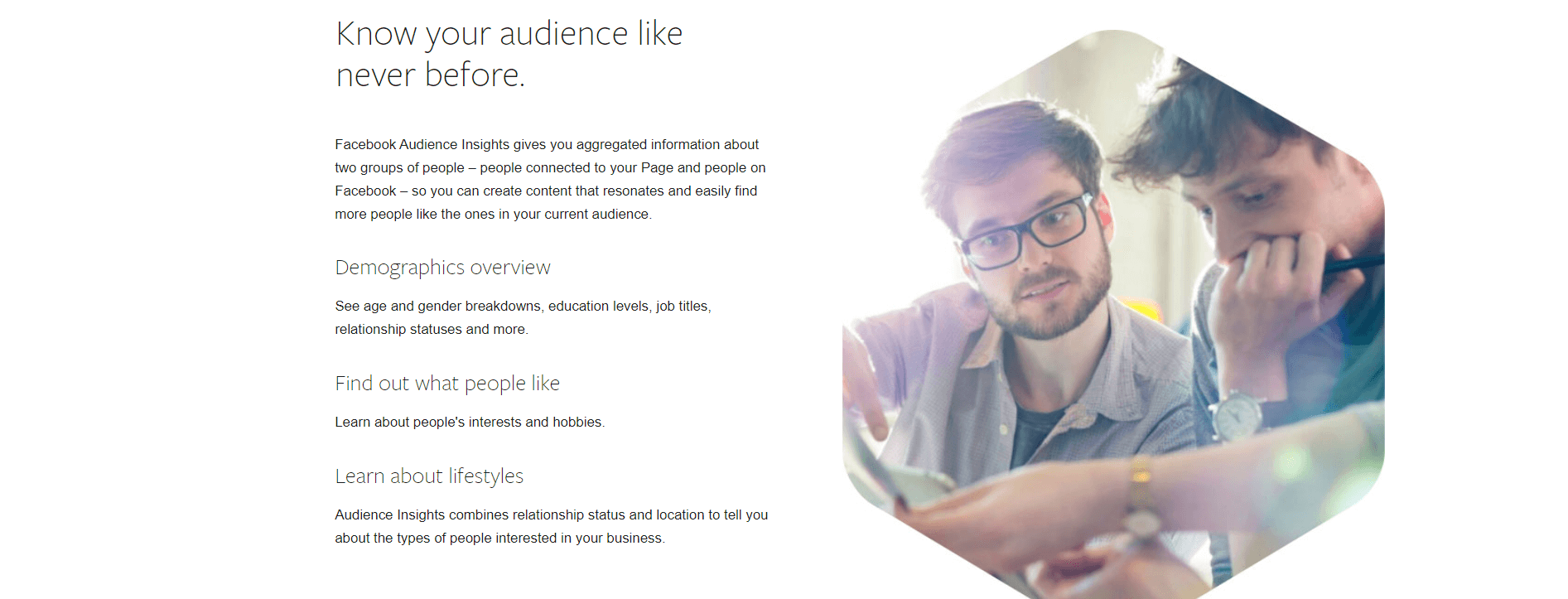
So, with what does the data on demographics help you?
It helps you narrow down the audience you call your Target market or Target Audience.
And what on earth is this *Target Market*, now?
Christina Newberry at Hootsuite defines the target Market as the people you want to approach with your marketing message. What makes them ideal for your message is their interest in the kind of product or service you offer
Now that you know what your target audience is, let’s get to some information, without which we wouldn’t be able to close the topic of the audiences:
What Are The 4 Types Of Audiences?
The topics of the types of Target audience/market and the market segmentation are somewhat synonymous
In case you are not clear about what a market segment is, here’s an easy definition for you:
It is a group of people that share common characteristics. Therefore this segment is taken as one whole to target for your product.
Each target segment potentially divides your audience into smaller, closely related chunks that have some features in common.
You reach the right audience or the target market based on these common features.
Basically, from a marketing standpoint, there are 4 important customer segments. You could practically make many types of audiences out of these segments.
Here they are!
4 Types Of Market Segments
The 4 types of market segments are:
a. Demographic
-
- Age
- Race
- Gender
- Education
- Employment
- Marital Status
- Location
b. Psychographic
-
- Personality features
- Believes
- Motivations
- Interests
- Focus and priorities
- Values
- Psychological influences
- lifestyle
c. Behavioral
-
- Brands or businesses targets interact with
- Purchase behavior
d. Geographic
-
- Precise location / Zip Code
- Town/village/city
- Country
- Climate
Now, here’s the best part:
Facebook helps you fish your target audiences out by means of one or more of these common characters in each segment.
How does that help you again?
It helps marketers and business in a variety of ways, mainly:
- Saves you bucks by not spending on those that do not matter to your business.
- Makes you dollars, too, by targeting the right audience that converts.
You can read about the detailed target analysis here.
For now, let us see each of the demographic factors in detail in the next section.
Facebook Marketing And Some Demographic Factors
a. Age:
Among the first few lines of information, you share with Facebook at the time of registration on the platform is your AGE.
So, Facebook knows your age, and that of your friends even if you don’t know that.
Here’s the part that should excite you:
Marketers can utilize the demographic age ranges data right off Facebook (or from other resources) to find their target group.
Here’s the age categorization for surveys.
b. Different Age Groups For Surveys
Generally, you’d find the following age ranges for surveys:
Though the age categories could vary broadly, these are the general age groups found categorized in data collected for research and surveys.
But the important question is, WHY DO YOU NEED TO FOCUS ON AGE?
Because for most products/services, only a specific age group would be interested and needs to be targeted in your marketing efforts.
Imagine this:
You are a chef, and you have recently started a home food business.
Sounds yum!
Your burrito could have been world-famous if all the fellow earthlings had access to it. So, you decide to launch a vegan version of your burrito.
Now, as a rule of thumb, you wouldn’t want to advertise your vegan burrito to a non-vegan.
Why?
Because when someone doesn’t lie in your targeted group (non-vegan, in this case), you have only a very fat chance to convert him.
And that sounds perfectly logical. Right?
That is precisely the case for age, gender, or any other targeting option for that matter.
If you do not stay within your targeted range, you waste your ad spent for close to no return.
Now, let’s apply the same rule on a situation for different demographic age ranges.
How To Target The Right Demographics Age Ranges – Example!
Your targeted age group for baby-food would be different against the targeted age group for the regular grownup’s food.
For an enchilada, you could probably hit up every age group, and it would still be a hit (as long as your product and ad elements are all on-point). All it would take you is to take a mouth-watering picture of an enchilada with dripping cheese. Create a similar picture with your words, and they are so coming for you!
But, try to mesmerize all the age groups with baby-food.
Oops, that hurt hard!
Now, target the best appropriate age you figured out during your survey as parents of young babies.
Do you see the climbing graphs now?
Because, baby food sure does mesmerize the parents of those young babies, especially when they do not have much time to prepare fresh every day.
So, that’s the thing with targeting the right demographics.
It feels really good (and the feeling is mutual for the targets and the business) and pays off really well.
Let’s shift to another concept now.
Do you think you know what the advertising demographic age groups really are? Did you ever think that having the right information on different age ranges is the next best thing to hitting the jackpot?
Carry on to the next section for the details on the concept of advertising demographic age groups.
a. Generational Marketing:
People belonging to certain age groups mostly have differences in their marital statuses, values, household income, behavior, usage of technology, etc.
Interestingly, most people belonging to a close age group tend to have somewhat similar habits, behavior, usage of technology, earning statuses, and other factors.
When it comes to targeting the right people, Customer segmentation based on such similarities (within a group) and dissimilarities (outside the groups) plays a huge role.
This customer segmentation based on the age group creates groups that are called Generations.
The marketing efforts directed to these generations, treating them as different audiences, are collectively termed as *Generational Marketing*.
Moving forward in this post, you‘ll find some interesting facts about different age brackets and age categories covered in Generational Marketing.
Different Generations And Age Ranges
Michael T. Robinson, founder and career coach at CarrerPlanner.com, identifies the following generations based on their age ranges/year of birth.
| Sr. no | Generation name | Birth years | Age ranges | |
| Between | to | |||
| 1 | The Lost Generation | 1890-1915 | 129 | 104 |
| 2 | The Interbellum Generation | 1901-1913 | 118 | 106 |
| 3 | The Greatest Generation | 1910-1924 | 109 | 95 |
| 4 | The Silent Generation | 1925-1945 | 94 | 74 |
| 5 | Baby Boomer Generation | 1946-1964 | 73 | 55 |
| 6 | Generation X | 1965-1979 | 54 | 40 |
| 7 | Xennials | 1975-1985 | 44 | 34 |
| 8 | Millennials, Gen Y | 1980-1994 | 39 | 25 |
| 9 | iGen/Gen Z | 1995-2012 | 24 | 7 |
| 10 | Gen Alpha | 2013-2020 | 6 | -1 |
(Update: Feel free to add +1 in each figure in the last two columns for each year after 2019 you read this.
For instance, as of 2020, Gen Alpha lies in the age group between 0-7).
- It is worth noting that some of the years overlap in some generations. Also, some of the years for each generation are different from different sources on the internet.
Let’s have an in-depth look at how these generations help us gain insights into our targeted group and help make better-informed decisions for advertising:
b. Age Demographics For Advertising
The Lost Generation
- Not many people between the ages of 105-130 would be alive today. Therefore, this generation holds no particular value for marketers and businesses today.
The Interbellum Generation
- Like already mentioned, this generation has its demographic age range overlapping with the lost generation.
- However, if at all, there would be barely a few survivors of this generation probably in the remote islands or close to jungles.
Would you be interested in marketing to those as good as dead or extinct people?
The Greatest Generation
- Lying between the ages of 96-110 as of 2020, these generations wouldn’t receive much different reception from marketers from the lost generation and the Interbellum generation.
The Silent Generation
- This is said to be the most educated and healthiest and wealthiest of the predecessor generations. Therefore this generation holds some good promises for marketers.
- Interestingly, they are into technology, but the stats would be different for them. Their usage of computers, mobile phones, tablets, and smart devices is comparatively lower in percentage than people below 65.
- They are more inclined towards text than images. Email Marketing would be a great connection builder with them keeping their preferences in mind.
- Another good way to approach them is through Television, probably radio too.
The Baby Boomers
- This generation is more likely to use print media and use less of the mobiles/tablets and more desktops. However, if it makes you think this makes them technology-illiterate, well…think again!.
- As per a report, this age range is most likely to spend money on technology as they have more disposable income.
- However, they are more inclined towards details and descriptions in the text, audio, or video.
- MarketingSherpa states that this age bracket doesn’t only rely on smartphone-based online purchases but uses desktops too. The purchase is well-researched and validated with reviews.
- However, it is not necessarily Social or Digital Media that compels them to research to initiate a purchase process. Television, radio and newspapers/magazines, etc. could also be the heroes-sans-cape here.
- However, based on their predictable behavior, they are assumed to be more reliable shoppers and customers.
Gen X
- This age range seems to have overlapping features of both the adjoining generations.
- They prefer simplicity in content that is short and precise. Their use of old and new technology (desktops, tablets, and smartphones) is frequent. And, they base their purchases on research/reviews. They are equally inclined towards written information and videos on the web.
- Calling them a *Forgotten generation* based on the fact that this high potential market segment is not being sincerely and dedicatedly addressed, Rieva Lesonsky states that this is the generation with the highest buying potential.
Here’s the best part!
- Mostly being content with their lives currently, they tend to save more, hence a good age group to target for future marketing campaigns.
Xennials
- This is called a micro-generation between Gen X and Millennials giving more accuracy to your targeting for advertising.
- They are the first generation to have used the internet at their homes. That’s how they grew, and that’s where they hung out.
- This could be one of your favorite target groups for their affinity to the internet and technology in general.
Millennial
- This age category, also called Y generation, is more addicted to Social media, a short version of the content (videos, blogs). They are more into discounts and coupons and prefer real life, useful content.
- This is the first, real tech-savvy generation as they were born and bred in the age of the blooming internet. This generation is found online for most of their days and could easily be targeted for online offers and purchases.
- The marketing route to them is NOT necessarily Facebook only since they network at almost every cyber platform there is. However, with the shortest attention span of 3-seconds, this age range seems to be the most difficult to be hooked.
- The comparison research between Baby boomers and Millennials on MarketingSherpa by Daniel Burstein and Dr. Liva LaMontagne states:
- “Shoppers ages 18 to 25 are 2.5 times more likely to view retail advertising on a mobile device — 24% versus 10% for shoppers 55 and up.”
- The same research states:
“Millennials are incredibly engaged with companies and brands on social media platforms,” Brad Jefferson, CEO and Co-founder, Animoto, said.”
iGeneration
- This generation is frequently called Post Millennial, Gen Z, or Homeland Generation. The ones graduating from colleges are getting jobs and salaries and hence are the targets for marketers for their products and services.
- Unlike the trends with other generations, they are more likely to be found more on Snapchat and Youtube. Facebook has been amongst their favorite time-killers as well in the past.
- With an attention span of about 8 secs, you can grab their attention with attractive multimedia usage.
- However, to make them your lifetime customer, brand ambassadors, and loyal clients, you have to sell quality to this age range, or you might end up buying yourself a bad name. And that bad name can go viral just as quickly in their hands.
Gen Alpha
- Between the ages of 0-7 years, this age group might not be the sweet spot for most marketers (unless you want to hook some of them up on Youtube, where they spend much time watching their favorite stuff).
- However, since this is a booming, living generation with real needs that are bound to increase with time, you’d have real products for them. If that stands true for you and your product, you need to find and pitch to their parents.
And, very good luck with that!
Now, that’s not all, but that’s all for the generations!
The trends change, and some of them might not apply to one or all of these age groups depending on the nature of your business. So marketers have to combine the data on age ranges for surveys with other demographic factors to get the right kind of insight on their real audience.
Using Age Demographics For Advertising On Facebook
Now, getting back to using the different demographic age ranges data for Facebook.
The best thing about most digital marketing platforms (count Facebook in) is that you can restrict the page reach to a selective audience based on age.
Now, compare this to Traditional Marketing.
Remember how we all used to mistakenly miss our favorite programs because we’d change the channel to avoid those imposing ads (and would forget to switch back the channel).
And remember the frustration of having to keep watching those irrelevant long advertisements (that took forever to end) just because we didn’t want to miss that one program anymore.
Facebook has revolutionized how you laser targets your market. And it pays off markets and businesses big time.
Let’s have a look at how to advertise selectively to your targeted demographic age ranges on Facebook:
There are 2 ways you can create ads. Both involve different steps in targeting audiences. Therefore, we’ll show you both the easy to selectively pick the targeted age groups.
1- Targeting Selective Demographic Age Ranges Right From Your Facebook Business Manager
While you are creating an advertisement from your Ad account in the Facebook business manager (BM), you are given the option to select the age ranges of your choice (starting from 13+ to 65+) based on your understanding of your target market’s age group.
You get to pick an appropriate age group at the ad set level in a campaign in the BM.
You can check out more restriction options at different levels in Jon Loomers’ comprehensive guide here.
2- Targeting Selective Demographic Age Ranges Directly From Your Business Page
There are two ways you can target selective age demographics right from the Facebook page.
I- Targeting Selective Age Groups For Your Facebook Followers – Organic Reach
a- Go to your Facebook business page.
b- Click on “Settings” right next to the help dropdown on the top right of the page.
c- You’ll find yourself on this page. Click on the blue-colored “Edit” tab in front of “Age restrictions” in General settings.
d- A drop-down menu opens up here for you to choose from. As you change the option of your audience here, click on “Save changes” and move on.
This is how your Facebook page’s organic reach would be limited to the selected age group.
As easy as a, b, c and D, we say!
II-Targeting Selective Age Groups Through Your Ads – Paid Marketing
a- Go to your Facebook business page.
b- Click either of the “Ad Centre” or the “Promote Button” on the left-side panel.
c- Either way, you’d land on the page where you’d be asked to pick your goal. You would have to – unless you do not want to proceed.
d- In the next step, you’d be asked to:
I- create your ad
II- pick your audience
- If you’re going to add a selective age group to target, EDIT your “Audience details” to set the age to what you want.
III- Add payment info
IV- Schedule
e- After adding all the info, click on “Promote Now” and enjoy the results of your campaigns targeting your desired demographic age ranges.
Easy as a, b, c, d, and e!
Okeh now, enough of the age obsession!
Try to forget that Facebook knows our real ages (if you entered the correct ones, that is, and you happen to be age-conscious).
Focusing on the fact – that Facebook uses this data to bring you the best matching products and services that could be useful to you – might help.
Now, let’s move on to other demographic factors.
a. Gender:
The data in Facebook audience insights shows that there are more women on Facebook than men.
As per the breakdown of age and gender for *everyone on Facebook*, the women account for 55% of Facebook profiles than men, who are just 45%.
Similarly, the age-wise breakdown shows that except for the age ranges of 18-24 and 25-34, where men outnumber women with a slight difference, women have a far higher ratio for any age brackets.
Update:
As of July 2020, different demographic age ranges have shown slight differences in the percentages as follows:
It is, however, interesting to see that the overall 55:45 ratio of females vs. males did not get disturbed over time.
Getting back to the original point now!
At the time of Ad creation, you are given the option to choose these demographic factors.
You can choose to show the ad either to your male audience or female audience or i.e. age both based on how you’d like your spendings to go or based on the previous advertising experience or the right market segment for your product.
You can even split test your Ad by making two ad sets for both genders if you are not very sure about the better option for your product/service.
b. Education:
Facebook shows the following stats for education based on the data provided by the users.
If you know some of the features of your target audience (i.e., age, location, gender, interests, etc.), Facebook can sort out this information for you for the selected audience.
All you will need to do is fill in the audience traits you want to check the education stats for on business managers’ audience insights menu.
You can use the same method to check any other feature for your audience as well.
Now, why do you want to know any of that?
Because you want to know more about your audiences now. Don’t you?
Facebook Audience Insights tool helps you dig deeper into your audience for a better understanding.
While creating an Ad, you can use this information to target the audience based on their education level.
You can even narrow down your audience based on their field of studies, the name of institutions, and the year of graduation with the help of the audience insights tool.
c. Relationship Status:
The data everyone has given Facebook on their relationship statuses is crazy and could be bankable for you if your business makes you interested in these statuses.
For example, your business can leverage the data to find all the married people in XYZ location if your products/services are directed to them.
You can choose from the different types of relationship statuses your business might mean something to and get an estimated audience for each type during Ad creation.
Imagine the usefulness of this data as a lawyer, for instance, who specializes in domestic issues.
Yes, you got right to the point.
d. Job Title:
You can keep marveling at all the different job titles Facebook can help you reach if they are your right audience type. However, don’t just keep wondering, and get to them before your competitors do.
And to reach them, type the relevant job title while Ad creation and enjoy the results.
So, now that you have all the essential details and demographics about the targeted audience on Facebook, get on your toes.
a- Create new audiences.
b- Create new ads (or use the existing, best-performing options)
c- let Facebook run your ads to those audiences and do its magic while you enjoy Netflix.
As easy as a,b, C!
Now, this information is mind-boggling.
But is this all you could make out of Facebook audience targeting options?
Bear in mind these are not the only targeting options in demographics. Facebook also offers you to reach people through their financial status, life events, parental status, etc.
Using your understanding of your audience (not only their demographics though), and combining the techniques to attract more people through your ads, you’ll see the results like never before.
Yes, that means boosting profits and continuous, sustainable growth.
Final Word!
The way you can use demographic age ranges and all the other demographic options through Facebook are additive, ecstatic, and profitable.
As a business owner or a marker, you’d be missing out on a lot of fun and revenue if you do not master the art of marketing to the right age demographic and the understanding of your audience. Age is one of the important dynamics of audience segmentation.
Make sure to learn and earn from it.
If you think you are interested in learning more about growing your business through Facebook marketing, check out our concise guide on 7 Facebook Marketing Tactics you should know.
But before you dive deeper to fly higher through Facebook marketing, share with us:
Do you still think that age is just a number? Or, do you now share our views on how using the write demographic age ranges could turn the tables for you.
Let us know in the comments 🙂
People Also Ask
What age group or demographic do most advertisers target?
What age group or demographic you target for your product or service mainly depends on your product or the service itself.
However, the age range between 18-34 has been the advertiser’s most favorite for a long time.
The reason?
This group of youngsters has disposable income for shopping and purchase behavior that makes them ideal for targeting.
What is a demographic targeting or a targeted demographic?
In behavioral advertising, advertisers target a particular segment of the consumers in the population. This targeting is based on the most useful demographic information for these advertisers. This segmented targeting is called demographic targeting.
What are the advantages of demography?
Selective or demographic targeting allows you to find a highly accurate group of prospects that are more likely to convert than the rest of the population.
Not only does that increase the conversion rate of your marketing efforts, but it also lowers advertisement costs.
What are the demographics examples?
Examples of demographics include age, race, gender, income, education, marital status, employment, and behavior, etc.
How do you target an older demographic?
Whether targeting a young or an older demographic, a few important considerations make the targeting accurate:
Study the buying behavior of the targets.
Use the language that speaks to the targets directly.
Use all the platforms where the target group hangs out.
Sell the benefits more than the products to be able to actually sell.
Make the message easy to understand.
How do you identify your target audience?
There are multiple ways to identify your target audience. The best researches make use of a combination of techniques and approaches:
Analyzing your current consumers.
Analyzing your product to see who it is useful for.
Researching the demographics that the product could be helpful for.
Inspecting the most useful demographic aspects.
Why is the target audience important?
A target audience is a group of individuals with similar needs and similar demographic characteristics. A business targets a specific or a set of closely related needs of this group with the help of its product/service by serving the needs.
What does it mean by understanding your customers?
In business and marketing, you can never be successful unless you know and understand your customers well. But first, you need to discern the difference between both the terms:
Knowing literally means you know them demographically; you know their ages, location, and where they are found or hangout. However, only knowing the customers can never be enough. You need to go a step further to understand them.
Understanding your customers means getting into their shoes to see why they need your product or services, their relevant problems, and probable solutions you could fetch them. For understanding them better, you need to learn their psychology and keep an eye on their preferences. You need to analyze which of your competitors are their favorites and what makes those competitors their top choice. That’s how you will learn about the loopholes that are holding you from winning.
It is only though the understanding of your target audience or demographic that you would be able to enhance their experience about your product or service. And that’s only how you make life-long high lifetime value (LTV) customers.
What age groups does Facebook Target
Facebook offers to target below, starting at the age of 18 to 65+. That means no one under the age of 18 would be able to see a Facebook ad unless he has created a fake account with incorrect age information or is guilty of using a guardian’s Facebook account.
What is an example of a Target audience?
A target audience could be defined as a group of people or your market that has been chosen to be targeted for your advertising efforts. You chose to target a particular market segment/audience because they are, or could make your ideal consumers.
For instance, if you are running a software house that makes retail management software on-demand, you wouldn’t target just everyone on Facebook. Depending on whether you provide online services to the prospects worldwide or you are restricted to a limited geographical location, your target location would vary widely. While age targeting, in this case, might differ as well, your primary targets would be retail store owners.
So based on the information you have for the people who would use your services, the demographics you’d target for advertising would be your target audience.
What age demographic uses Facebook the most?
According to the Facebook Audience insights tool, currently, the 25-34 age demographic uses Facebook the most. Interestingly, the trend remains the same individually for both the genders and everyone on Facebook, collectively.
Out of the total women population on Facebook, 32% belong to this age group. As for the total men on the platform, 36% belong to this age bracket.
Why is generational marketing important?
With generational marketing, you get the option to reach a specific target group based on their age group. Targeting a particular age bracket allows you to reach people based on their similarities and dissimilarities. This selectively targeted reach promises high returns (if the targets being reached are the right targets).



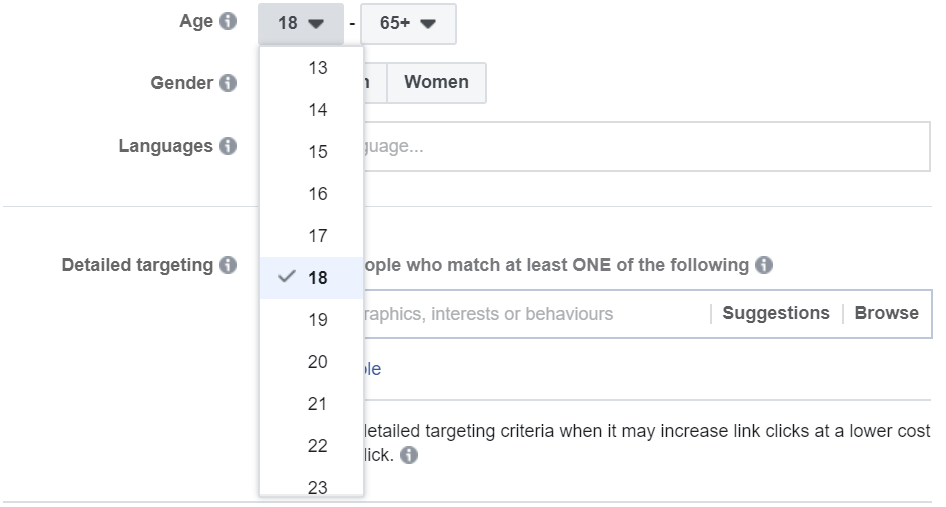
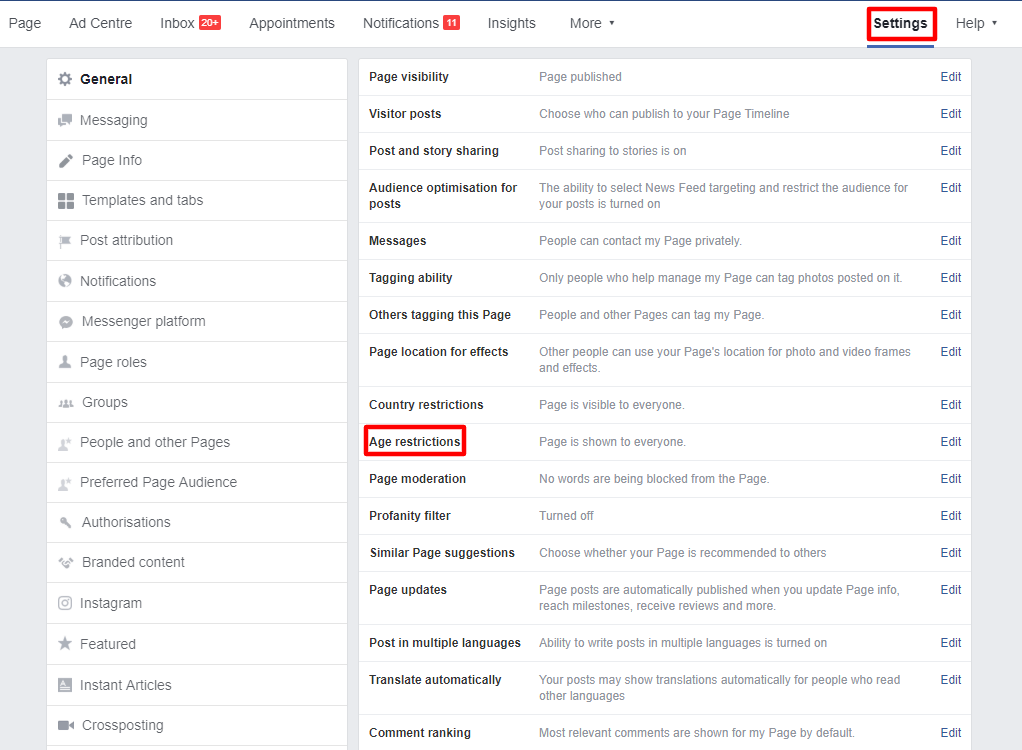

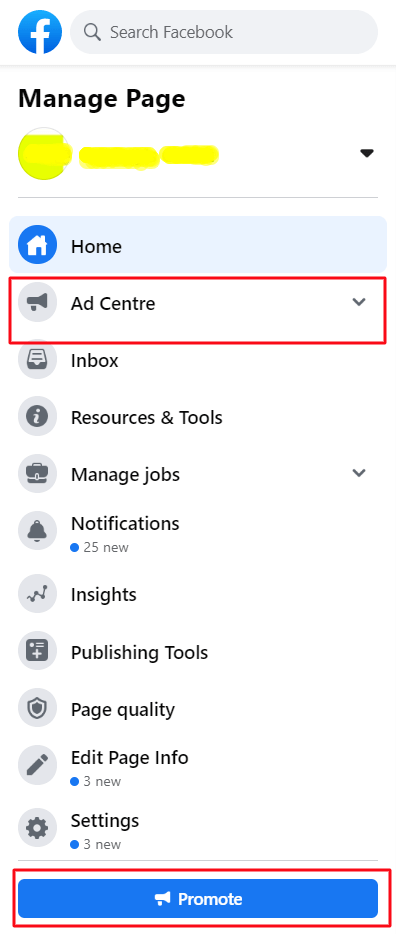

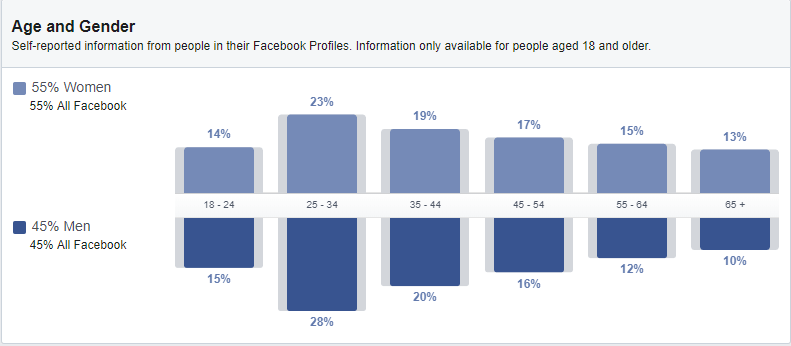





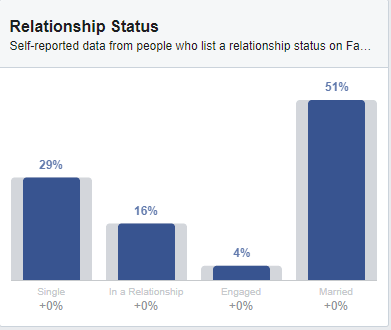
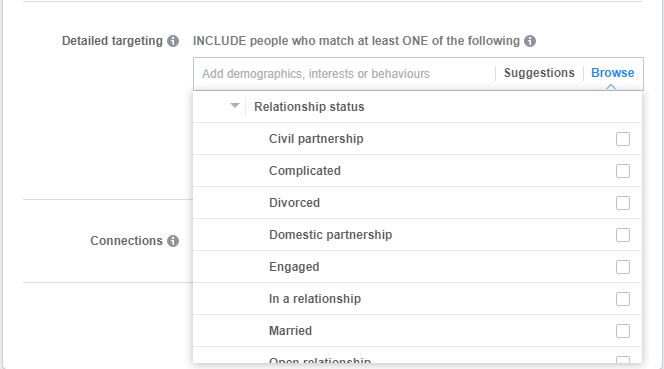
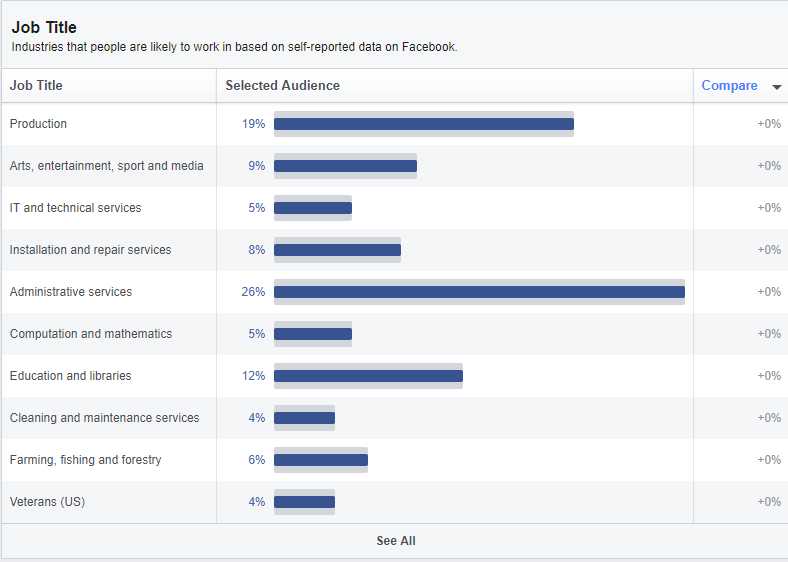
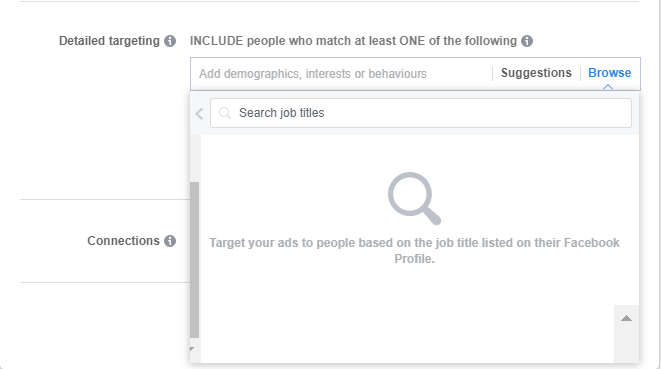
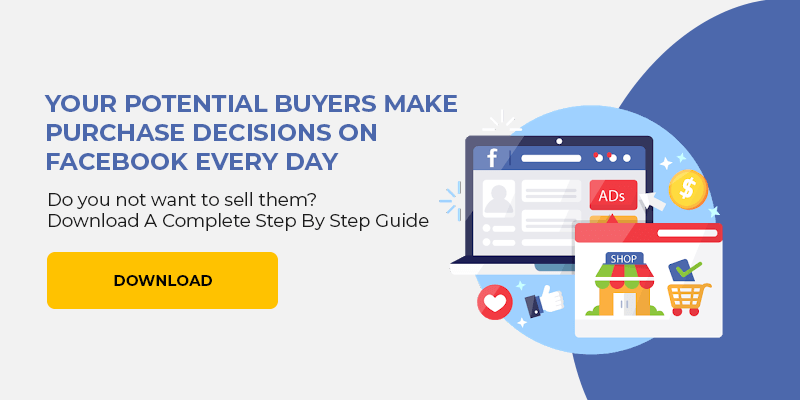




Leave a Comment